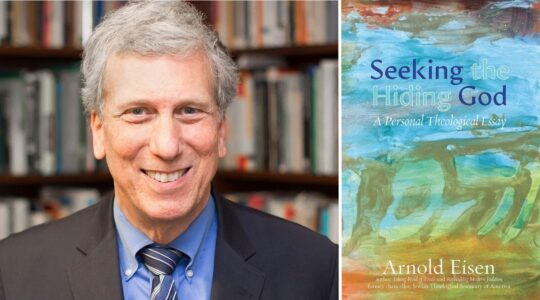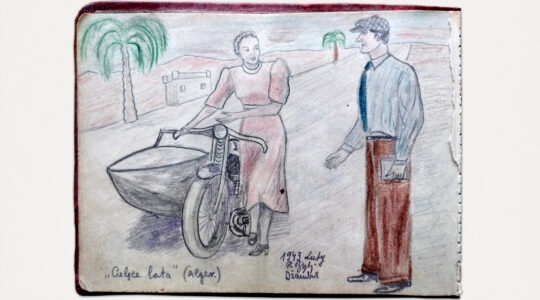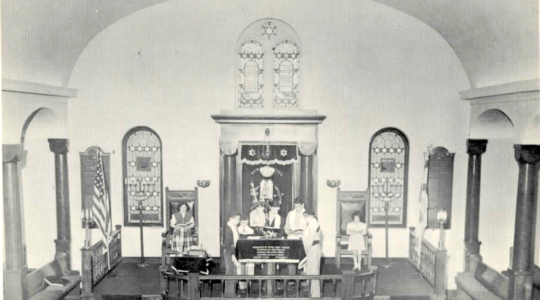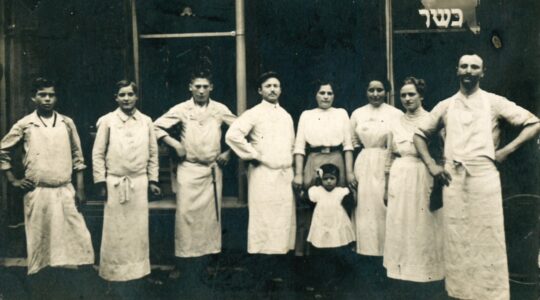Brzezinka, Poland — A group of Polish soldiers, in full uniform and with their national flag, stood pensive as Hebrew music blared on loudspeakers across Birkenau. “May peace be within your walls,” sang the sweet female voice.
Taken from the Book of Psalms, the lyric echoed across the massive space between Birkenau’s walls — walls that were constructed to keep members of our people captive and ready for gassing, and keep rescuers out. And as it did, there was peace between these walls.
A few yards from the Polish soldiers, a woman held a German flag, sewn to an Israeli flag. It was a moving sight — the flag of the country that perpetrated the Holocaust (albeit a different flag to the one flown in those dark times), held proudly in Birkenau, brought in solidarity with the Jewish people.
Andrea Barwkig, a 47-year-old social worker from Frankfurt and a practicing Christian, clutched one side of the flag. “Our German relatives were involved in so many things here with the Nazis so it’s important to take part in this event against racism and anti-Semitism,” she told me. “As anti-Semitism rises again, it’s particularly important.”
This was last Thursday, Yom HaShoah, and there were some 11,000 people in Birkenau participating in March of the Living — around a third of them non-Jewish. For most, the day’s ceremony was the conclusion of several days in Poland, touring sites related to the pre-war Jewish communities and to their destruction.
Within Birkenau’s walls, Jews and non-Jews were at peace with each other. People from countries that fought in World War II with the Allies were at peace with people from countries that fought on the other side. And Jews of different religious and ideological stripes were at peace with each other.
It was difficult to recognize this as belonging to an ilk of Holocaust trips that “fail the objective of Holocaust remembrance itself” and “eliminate the diversity of voices essential to ensure that the imperative of remembrance is broadly observed.” Yet these are claims raised by a New York academic in an article titled “What’s Wrong with March of the Living.”
Jessica Lang, associate professor of English at Baruch College and the Newman director of the college’s Wasserman Jewish Studies Center, wrote about an undergraduate trip to Poland that she runs. It takes place as part of her course, “The Holocaust and Historical Memory,” a rigorous academic syllabus which aims — according to its prospectus — “to introduce students to a range of Holocaust documents: historical, artistic, literary, religious, and philosophical and then talk about these texts both in the abstract and in the shadow of the actual event.”
In her piece for JTA she described how she runs her Poland trip in line with her course’s high academic standards, which is laudable. But she then proceeded from this to disparage trips like March of the Living. “Typical Jewish teen tours hold themselves to a poorer standard,” she wrote, before unleashing her comments about eliminating diversity and failing the objective of remembrance.
March of the Living doesn’t hold itself to the same academic standards, but so what? It is an open-for-all trip for the mainstream, not a study field trip for undergraduates. Its participants are mostly younger than Lang’s, and in need of far more basic educational content. It is a program that pitches correctly to its audience — and why should it be looked down upon for doing that?
Rather, it should be applauded for getting so many young people involved and for turning itself into such a mass event. Talking to the young people on March of the Living I was left wondering how many other serious-themed trips for teenagers anywhere in the world have so much appeal, and get people of this age choosing to see so much history, and becoming so engaged in it.
Support the New York Jewish Week
Our nonprofit newsroom depends on readers like you. Make a donation now to support independent Jewish journalism in New York.
It fails the objective of remembrance because it engages in “sheer simplification,” Lang writes, “making the genocide of European Jewry a subject to be explored among friends rather than the profound wrestling with history and its consequences.”
March of the Living tours simplify to suit the audience, but so do all tours. Within the context of the short tour, their limited background and the simplification, I found participants’ reflectiveness highly impressive. And since when is exploring something among friends mutually exclusive from “wrestling with history and its consequences?”
In fact, it is the social element that has made March of the Living so popular in attracting many youngsters who would never normally sign up for a Holocaust tour, and there is a certain poetry in seeing so many young Jews, full of energy and even flirtation, convening in places that were meant to ensure the end of Jewry. One Birkenau survivor, Ziggy Shipper, told me that the massive crowd of youngsters made attending March of the Living “one of the greatest things” that he ever did.
While the Jewish youngsters travel in Jewish groups, March of the Living does not “eliminate” diversity in commemoration, as Lang suggests. Yes, it openly promotes Jewish identity, but it also places value on universal commemoration and, as mentioned, welcomes many non-Jews.
As a theology postgraduate at the University of Cambridge, in my work since then as a journalist, and in various other contexts, I have studied Jewish life and death in programs run to the standards that Lang prescribes. And I have also attended numerous teen programs like March of the Living, where strong identity, social and emotional elements mix with a more relaxed educational approach. Both of these approaches play a valid and important part in Holocaust commemoration.
The call of our times is to “never forget,” and to ensure that everybody knows about the Holocaust. But not everybody is an undergraduate in a Western academy or suited to the kind of study that such an institution expects. Most people aren’t.
As survivors die out, the role of Holocaust sites in communicating what the Nazis perpetrated against their victims will become more and more important. Precisely by developing tours that suit everyone, not just an intellectual elite — tours that can serve as a model for people from all countries involved in the surge in Holocaust-related tourism in the coming years — March of the Living has done hugely important work in helping to prepare for this era.
Nathan Jeffay’s column appears twice a month.
The New York Jewish Week brings you the stories behind the headlines, keeping you connected to Jewish life in New York. Help sustain the reporting you trust by donating today.




